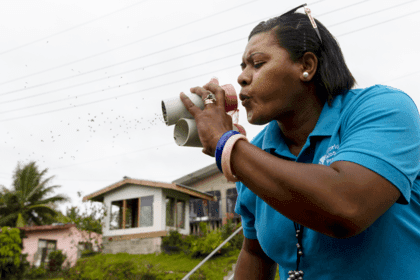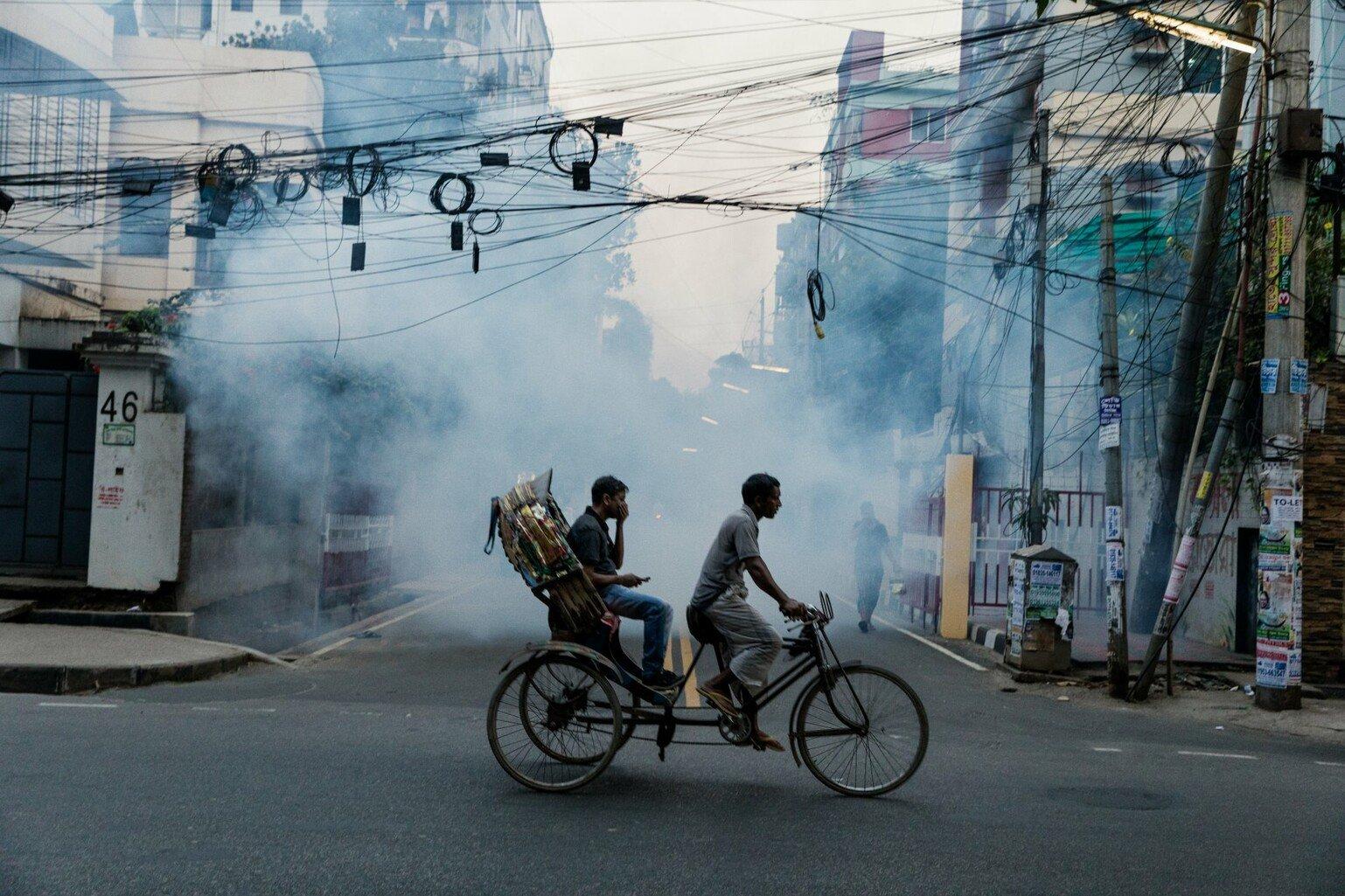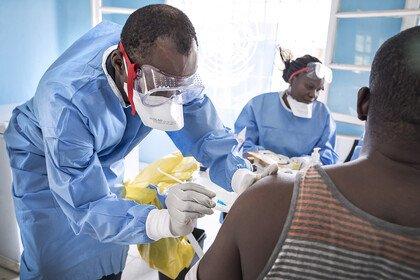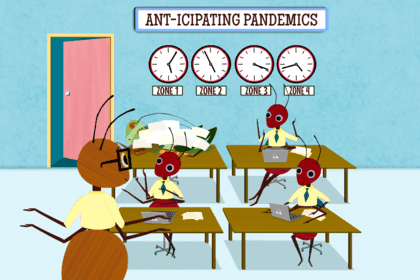
What is a zoonotic disease?
Zoonotic diseases represent a major global public health problem due to our close relationship with animals. But what are they, how do they spread, and how can they be prevented?

The streets of Uttara, a suburb of Dhaka that has expanded rapidly over the past 20 years, are sprayed with insecticide to exterminate mosquitoes during an outbreak of dengue. This process of 'fogging' is unlikely to have much success in preventing an outbreak from spreading as it targets only adult mosquitoes, leaving eggs and larvae unharmed.
Despite its limited efficacy, the fumigation process gives communities a sense of reassurance that some effort is being made to protect them.
Adrienne Surprenant / Agence MYOP, Wellcome
Summary
Explained: zoonotic diseases
- A zoonosis is an infectious disease that jumps from an animal to humans, for example rabies.
- Many factors increase the risk of zoonotic diseases, including the climate crisis and intensive farming.
- To ensure future zoonotic outbreaks do not lead to pandemics, we need more investment in research and development, governance, financing, community engagement and education.
The world is full of microorganisms. They include things like bacteria, fungi protozoa and viruses, many of which can cause disease.
We call microorganisms which cause disease 'pathogens'.
When one pathogen jumps from one species to another species that isn’t familiar with it, it can exploit that new host's lack of defences, and cause illness.
When a pathogen jumps from an animal into humans it is called a zoonosis (also referred to as a zoonotic disease).
Zoonoses comprise a large percentage of all newly identified infectious diseases as well as many existing ones. Around 60 percent of human infections are estimated to have an animal origin, and of all new and emerging human infectious diseases, some 75 percent 'jump species' from animals to people.

Source: Royal Society Publishing
More than 330 diseases emerged between 1940 and 2004. Of those, nearly two-thirds were zoonotic and over 70 percent of those originated in wildlife, as opposed to domesticated animals.
How do zoonotic diseases spread?
Because of the close connection between people and animals, it’s important to be aware of the common ways people can get infected with germs that can cause zoonotic diseases.
These include:
Direct contact
Coming into contact with the saliva, blood, urine, mucous, faeces, or other body fluids of an infected animal.
Example disease: Rabies
Cause: Bites, saliva, or when animals are killed for food either abbattoir workers or for bushmeat trade depending on context.
Indirect contact
Coming into contact with areas where animals live and roam, or objects or surfaces that have been contaminated with germs. Examples include rodent infestations, pet habitats, and chicken coops, as well as pet food and water dishes.
Example disease: Lassa fever
Cause: Inhalation of dust contaminated with rodent urine or droppings.
Vector-borne
Via an intermediate species, which carry the disease pathogen without getting sick. For example, being bitten by a tick, or an insect, like a mosquito or a flea.
Example disease: Plague
Cause: Bites of infected rat fleas.
Foodborne
Eating or drinking something unsafe, such as unpasteurised (raw) milk, undercooked meat or eggs, or raw fruits and vegetables that are contaminated with faeces from an infected animal.
Example disease: Nipah
Cause: Ingestion of date palm sap contaminated with fruit bat urine/faeces.
Waterborne
Drinking or coming into contact with water that has been contaminated with faeces from an infected animal.
Example disease: Campylobacter diarrhoea
Cause: Farming run-off or animal faeces contaminating watercourses.
Zoonotic diseases represent a major public health problem around the world due to our close relationship with animals in agriculture, as companions and in the natural environment.
Pressing play on the video above will set a third-party cookie. Please read our cookie policy for more information.
The world loves animals.
In 2015, 57% of people worldwide owned a pet. And it's estimated that 1 billion people globally work with animals. But our close relationship with animals comes at a risk.
Zoonotic disease, also known as a zoonosis, is an infectious disease that has jumped from an animal to humans. Around 60% of human infections are estimated to have an animal origin.
Zoonotic diseases represent a major global public health problem due to our close relationship with animals in agriculture, as pets and in the natural environment.
There are four things that are contributing to the rise in zoonotic diseases:
1. Urbanisation and the destruction of natural habitats
2. Climate change
3. Food production
4. Travel and transportation.
Future zoonotic outbreaks might be inevitable, but with the right precautions, it should be possible to ensure that they do not lead to pandemics.
What increases the risks of a zoonotic disease emerging?
To quote Benjamin Franklin, “an ounce of prevention is worth a pound of cure”.
Expenditures for prevention and preparedness are measured in billions of dollars. The cost of a pandemic in trillions. We need to understand how, where and why a zoonotic disease may emerge so that we can develop prevention strategies to deal with the problem at the source.
Urbanisation and the destruction of natural habitats
While many factors are involved in disease transmission, scientists are increasingly turning their attention to how altering land interferes with a pathogen’s journey from animals to humans.
Our land use has accelerated in the last 100 years. We have used up over half of the terrestrial land on the planet. And as humans transform wild animal habitats, the likelihood of human-animal interactions increases which increases the chance of zoonotic disease emergence.
A study published by researchers at Montpellier University and Aix-Marseille University found a link between changes in global forest cover between 1990 and 2016 and an increase in reported epidemics. As forest cover shrank (from 31.6 percent to 30.7 percent) occurrences of diseases rose, particularly in tropical, biodiverse areas.
Climate change
As the planet heats up, the range of infectious diseases that were once confined to warmer latitudes is slowly expanding.
Zoonotic diseases benefit from greater range made available by climate change. One group of zoonoses, vector-borne pathogens – such dengue or malaria – pose an increasing risk to human health and are being found in new areas for the first time.
Food production
There are several issues linked to our food and agricultural systems that increase the likelihood of a zoonotic disease emerging.
Intensive farming
The highly unnatural conditions of a factory farm – where up to tens of thousands of animals are crowded together indoors – provide the perfect environment for the rapid spread of viruses and bacteria to many animals. As a pathogen spreads through thousands of new animal hosts on a factory farm, there is a much greater chance of it mutating, risking the emergence of strains that are not only more harmful but which have zoonotic potential.
The 2009 global swine flu pandemic was caused by a virus that spread in farmed pigs and developed the ability to infect humans. It started in Mexico, just five miles from a major concentration of intensive pig farms and went on to kill up to half a million people worldwide. This was a relatively minor influenza pandemic and could have been much worse.
Moreover, intensive farming operations often have a high use of antibiotics for farm animals. This puts farmworkers at increased risk of pathogens resistant to current antimicrobial drugs. The use of antibiotics in animals raised for food is widespread and increases the potential for drug-resistant strains of zoonotic pathogens capable of spreading quickly in animal and human populations.
Wildlife trade and consumption
'Wet' markets housing different live animal species and selling the meat or by-products of wild animals are particularly high risk. There are a large number of new or undocumented pathogens known to exist in some wild animal populations. As wet market conditions are often confined, leading to a high level of mixing of different live animal species, it makes them a hotspot for infection.
The World Health Organization, World Organisation for Animal Health and the United Nations Environment Programme provided new guidelines for governments to reduce the risk of transmission of zoonotic pathogens to humans in food production and marketing chains. These include suspension of trade in live caught wild animals of mammalian species for food or breeding, as well as a shutdown of food markets that sell them. It also urged governments to bolster regulations to improve standards of hygiene and sanitation in traditional food markets.
Travel and transportation
Diseases can now move around the world in periods shorter than their incubation periods (the time between exposure to a pathogen and the first clinical sign of illness and are likely to be infectious). The increasing amounts of human travel and trade, including the increasing handling, transport and (legal and illegal) trade of animals and animal products, increases the risk of zoonotic diseases emerging and spreading.
For example, there was a large outbreak of mpox in the US in 2003. This outbreak was the result of a virus spread from imported African wild mammals that were housed alongside prairie dogs. The prairie dogs became infected and were then adopted as pets across multiple states.
How can zoonotic diseases be prevented and controlled?
Prevention methods for zoonotic diseases differ for each pathogen and the route of transmission. Future zoonotic outbreaks might be inevitable, but with the right precautions, it should be possible to ensure that they do not lead to pandemics.
Areas that require further investment include:
Science research and development
Research and Development
The world's response to Covid-19 was to rapidly increase investment in research, manufacturing and distribution of Covid-19 tests, treatments and vaccines. But we’ve not seen the same increase in research and development (R&D) for diseases that are at risk of becoming the next pandemic.
We can learn from the world’s response to Covid-19 and invest in better diagnostics, while improving existing and developing new treatments.
At the same time, we need to understand the basic characteristics of zoonotic disease. We need to discover how spillover events occur, so that we can better prevent and respond to outbreaks when they occur.
We’re funding research to better understand what causes and drives infectious diseases to escalate and the solutions to control their impact.
There are currently no open funding opportunities for Infectious Disease. Learn more about the funding we provide.
Surveillance
To prevent the spread of pathogens, we need to know where they are as soon as possible. We also need to be able to spot any changes or variation in the pathogen which may affect how easily it spreads or how much people get sick – such as we do for variants for Covid-19.
Building locally-owned, internationally-connected genomic surveillance networks will ensure we can spot potential dangers before they become a global problem. This network must work with local communities and be used to monitor and tackle infectious diseases before they become urgent global threats.
With sustainable, long-term investment this network can inform powerful regional and international responses to all infectious diseases rapidly and efficiently. Having real-time information from surveillance systems will also be an invaluable resource to inform the development of tools like vaccines and treatments against new emerging diseases.
Governance and financing
Regulation
We need to develop effective means of monitoring and regulating practices associated with zoonotic disease. Rules to govern food production, as well as water standards should be considered. Such regulations could help to reduce the potential for foodborne zoonotic disease outbreaks through foods such as meat, eggs, dairy or even some vegetables.
To be effective, it is vital that rules should be set and monitored by local governments, and that education campaigns are conducted by public health groups at the same time so that they are embraced and adopted by local communities.
It is important to note that preventative measures are not always affordable to implement. There is often a cost to adoption or implementing new rules, so it’s important this is balanced against the benefit of the rules and assistance is provided to those affected.
Financing
Global solutions need collective investment.
Vital tools, vaccines and treatments rarely get developed when there are few cases of an infectious disease. Yet when there is a crisis, the world is left to scramble to find solutions. People die as a result, and outbreaks become epidemics or even pandemics.
We need governments to build collective financing mechanisms to transform the world’s ability to prepare for and respond to infectious disease threats.
Wellcome founded CEPI in 2017 to find solutions to some of the world’s most dangerous diseases when the market cannot. At the heart of its work, CEPI makes sure the tools it creates are accessible to everyone who needs them, wherever they are. Ultimately, it aims to develop lifesaving vaccines against any new, unknown disease within 100 days of the pathogen being sequenced.
Community engagement and education
Community engagement and social mobilisation are central to effective prevention, control and preparedness.
Governments and scientists should raise awareness and increase understanding of zoonotic and emerging disease risks and prevention (where appropriate), at all levels of society to build widespread support for risk-reduction strategies.
Education campaigns should be considered to promote behavioural adjustments that can reduce community spread of zoonotic diseases when they occur. For example. education campaigns to promote handwashing after contact with animals and other behavioural adjustments can reduce community spread of zoonotic diseases when they occur.
Wellcome has new teams working on reservoirs of disease, disease tracking, surveillance and sites and systems. These teams will look at how we can support R&D to identify and respond to potential future pandemic threats and enhance pandemic preparedness for all globally.
With thanks to Peter Hart, former Senior Research Manager at Wellcome, Josie Golding, Head of Epidemics and Epidemiology and Alice Jamieson, Policy Lead for contributing to this article.
This article was first published 2 February 2022.

